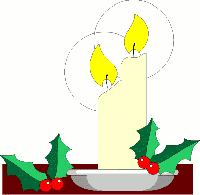
Thursday, December 31, 2009
Thursday, December 24, 2009
The Ghosts of Christmas

Charles Dickens from Wikipedia daguerreotype by Jeremiah Gurney
Hey, there's one undisputed master of the Christmas ghost story, Charles Dickens. Not only has he written the ultimate Yuletide tale A Christmas Carol with four co-starring specters, but he penned a series of Christmas novellas and also written many books based on the holiday theme.
Charles Dickens' fascination with ghosts and the macabre goes back to his childhood, to the ghoulish stories told him by his nanny, Mary Weller, whom he referred to as Mercy, "though she had none on me." And in justice, Weller didn't think Dickens was exactly an ideal charge, either. Maybe that's why she tried to scare the bejabbers out of him.
Not only did Mary's spooked out bed-time stories stick to young Charles, played back to him ad nauseum in his dreams, but reality added its lumps of coal, too. His dad was tossed into debtors prison when he was twelve, forcing him into the English factory system to earn his daily bread.
That was a sure nightmare maker, especially for a boy of the gentry who had none of the thick skin and street smarts of his brother urchins. He was humiliated by his circumstances, but drawn into the previously unknown world it introduced to him. The experience left him a champion of the underclass after he returned to the genteel life.
There were other influences on his sudden epiphany on the horrors of the Industrial Revolution on families, particularly kids, and the supernatural.
He toured the Cornish tin mines and Field Lane Ragged School for street orphans, visited the Western Penitentiary in Pittsburgh, had a decade-long fascination on both sides of the Atlantic with spiritualism; and was a fan of satirist and social commentator Douglas Jerrold, whose Punch magazine article How Mr. Chokepear Keeps a Merry Christmas featured a prototype Scrooge.
In 1843, Dickens published A Christmas Carol, partly as a social tract but mainly to relieve a money crunch. He wrote it in six weeks, hastened along by the memory of his father's time in gael - they should use the same concept for Wall Street - and a holiday deadline. It was a hit, critically and financially.
It was only the first of many holiday pieces; Dickens was nearly obsessed with the Christmas metaphor. He churned out other Christmas tales where the world weary were shown the light by spirit guides: The Chimes, The Cricket on the Hearth, The Christmas Goblins, and The Haunted Man and the Ghost’s Bargain, all borrowing various elements from A Christmas Carol.
All in all, he wrote at least sixteen stories centered around Christmas, though most passed on spooks and eventually ended their twisted trail with tidings of joy. Of course, some were written because the reading public expected a story from Dickens during the holidays because of A Christmas Carol. Others, well, because, in Dickens' words:
"I have always thought of Christmas time, when it has come round, as a good time; a kind, forgiving, charitable time; the only time I know of, in the long calendar of the year, when men and women seem by one consent to open their shut-up hearts freely, and to think of people below them as if they really were fellow passengers to the grave, and not another race of creatures bound on other journeys."
While most of Dickens' novels were along the lines of "Great Expectations," "Oliver Twist," and all his other caste-based classics, he was also quite a prolific contributor to the Brit magazine scene that thrived in his era. And he could write a ghost story as well as any of the popular tale-spinners of the day.
The Complete Ghost Stories of Charles Dickens, collected by Peter Haining, contains all twenty of Dickens' spook sagas. And his tales of redemption brought on with the help of the netherworld still live on in movies and on the Broadway stage.
Dickens may not have left any personal ghosts to haunt the living, but he sure did his part to make sure that spooks became a mainstay of our holiday season by providing us with his own version of the herald angels.
It's a good season to be reminded that, as he believed, "We forge the chains we wear in life."
Saturday, December 19, 2009
Maple Grove Inn
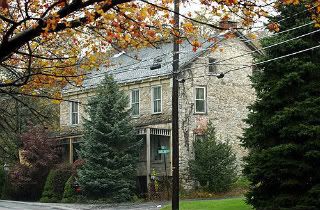
Inn at Maple Grove from the Morning Call
John Keifer built the Maple Grove Inn in Alburtis, Lehigh County, as a hotel in 1783, and it later became a stagecoach stop. Now it's a State Street restaurant called The Inn at Maple Grove, serving classic American fare...and a bit more.
It features the stories of two spooks on its' menu. The first is an Indian nicknamed Charlie who was hung in the Commons Room, now the dining area, in front of the fireplace for impregnating a white woman. It's said lighting the fireplace usually is enough to get a rise out of Charlie.
His supposed victim, it turned out, was a willing participant to the match, unbeknowst to the vigilantes and the kangaroo court jurists, and the Indian vowed to haunt the Inn to protest of the injustice of it all.
His footsteps can be heard, he shakes the fireplace tools, makes the chandeliers swing, plays with the lights & door locks, makes rapping sounds, whistles, and generally makes a nuisance of himself. He's sometimes seen as a mist or dove. His body is buried either under the fireplace's hearthstone or in the basement, depending on which version of the story is being told.
The other spook has been seen upstairs. He's the spirit of a man that was allegedly murdered in a closet on the second floor, and is most commonly associated with footsteps heard when no one's around.
Their tales are told in Ghost Stories of the Lehigh Valley by Charles Adams III and David Seibold and Haunted Places by Dennis William Hauck.
Saturday, December 12, 2009
Landon House

Landon House from Architectural Concepts
The Landon House was built along the Rappahannock River in Virginia as a silk mill in 1754. It was relocated (by barge!) to Urbana, Maryland in 1840 where it became The Shirley Female Academy and then the Landon Military Academy & Institute.
During the first Maryland campaign of the Civil War, it was the headquarters of General James Ewell Brown "Jeb" Stuart. Virginia gentleman that he was, Stuart hosted several social events at Landon, including the renowned Sabers and Roses Ball, a soiree for the rebel troops.
The ball was held on September 8, 1862. Twenty-four hours later, the Battle of Antietam, the bloodiest day of combat in American history, erupted.
The house was a hospital for both Union and Confederate troops during the battle and still has the original signed and dated Civil War “lightning sketches” on its walls, drawn by Yankee and Rebel soldiers.
Portraits of Abraham Lincoln and Jefferson Davis, along with General Robert E. Lee, remain. Landon House, located on the Urbana Pike, is on the National Register of Historic Places and is a stop on Maryland’s Civil War Trails program.
Since the hospital days, employees and visitors have witnessed many eerie events in the Landon House and on its property.
The house is reportedly haunted by the civil war soldiers who died in the building, seen by many Landon guests. Orbs are also common phenomena. Ghostly lights have been seen moving through the house late at night.
These soldiers are thought to be residual hauntings, energy that is left behind after an especially emotional or traumatic experience. Death would certainly qualify as one such experience.
Folks who have taken pictures sometimes find Civil War soldiers in the developed prints. One pair of reenactors allegedly have a snapshot of a ghostly apparition looking out of the windows, keeping an eye on them as they toured the house.
Construction workers told of a Union soldier who walked out the nearby woods, waved to them, and disappeared. There were no reenactors or anyone in costume on the site that day.
One reb soldier that has reportedly never left is Colonel Luke Tiernan Brien, an aide to Stuart, who has been seen sitting in a rocking chair on the front porch, looking out over his property (he was a later owner of the Landon House). He died in 1912. More often, the chair is reported rocking by itself.
An old spirit is sometimes reported to roam the house halls; many assume it's Brien, still padding around his old digs.
One spooked-out part of the house is the basement area. It is believed to be home to the slaves who were once held there. If you visit this spot, it's said that you may encounter an icy cold sensation, the sense of being watched, and maybe a tap from an unseen entity.
The basement is also home to one of Landon's prized legends, the ghostly hounds. The cellar wall has unexplained scratch marks from claws on the wall, and the most common paranormal report from Landon is the howling of dogs, heard from the deepest level of the house.
They're supposed to be the remnants of an ethereal pack of dogs that were kept in the basement over the years by a variety of owners, used for hunting, as an early home-security system, and to keep the slaves from escaping.
Another famous pooch spook haunts Landon. The dog was accompanying its owner during the battle of Antietam, was wounded, and brought to Landon House, where it died. It's never left.
One photographer captured a ghostly woman and her dog in one picture; pooches apparently were a big part of Landon's early history.
And there are the more mundane reports, such as Civil War music playing, and rolling cannon balls. But not all the ghosties are from the Civil War. A couple of apparitions are from the Shirley Female Academy days.
There is a legend about a woman whose baby died at birth. The woman lost it; she sat in a rocker and rocked the dead baby for three days before admitting it was gone. Her spook has allegedly been seen on the balcony entrance of her room at night.
A ghostly woman in white is rumored to roam the second-floor rooms. And she's on a mission - it's said that she's doing a bedtime check, looking for children to tuck into bed. A kid or two have even reported her visit to their parents. There's nothing like the ministrations of a netherworld nanny to speed you off to dreamland.
The Landon House, now a wedding and events center, embraces its spookiness. "We are happy to include an historic tour or 'ghost walk' of Landon House with your special event at no extra charge" boasts its website.
A Landon House Ghost Walk is hosted every Friday evening from April through September. It even rents out to paranormal groups that want to spend an evening tracking down Landon House legends.
So if you're planning to take the plunge or celebrate a big event and don't mind a couple of twilight zone gatecrashers, the Landon House is your haunt.
Friday, December 4, 2009
Southern Mansion
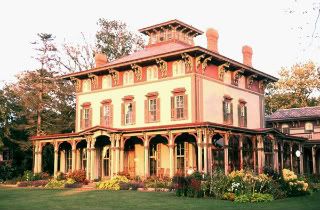
The Southern Mansion from Eras of Elegance
A wealthy industrialist, George Allen, built the Southern Mansion as a summer home for his family in 1863. Cape May was a getaway for the rich and famous, and the Italianate-designed Mansion was one of its featured homes (it's now part of Cape May's historic district).
The Allen's house sat on a acre and a half estate, lined with trees and dotted by Italian gardens, with mahogany woodwork, intricately carved crown moldings, fifteen feet ceilings, giant gilded mirrors, grand ballrooms, and 5,000 square feet of verandas surrounding it. Allen and his family summered there for 83 years.
George's niece, Ester Mercur, and her husband were the last of Allen family to call the mansion home. Ester loved the estate, and when she died, her husband, Ulysses, couldn't bear to remain there without her, and sold the whole shebang for $8,000. He was in an emotional rush to get out, and didn't vet the next caretakers very well.
The new owners turned the place into a boarding house. They painted the beige structure white, and converted the mansion into a rat's nest of small rooms to let. It gradually evolved into a poorly kept flophouse, and after 50 years, the hotel license was yanked because of the deplorable condition of the once-proud building.
In early 1994, the mansion was bought by its current owners, who turned it into a boutique hotel and event center. In just 18 months, after carting out 25 dumpsters of accumulated junk, the mansion was fully restored and renovated back to the spittin' image of its glory days.
The original owners must have liked the restoration. Some of them came back to enjoy their old home as yappy specters, while another had a complete attitude make-over.
First, voices and hushed conversations have been heard and reported from all corners of the Southern Mansion. It's thought that ghosts of the mansion's summer home era have returned, enjoying the building as in days of yore. Paranormal investigators have captured the spectral talk on EVP.
There's also one spooked out, but unidentified, room that weighs heavily on its mortal visitors. Folks claim that they get the feeling of anxiety and tension when they enter the space. There's never been a report of an apparition present, just a universal sense of angst.
It's believed that a highly emotional death occurred in the room, like a suicide, murder, or illness/accident.
But hey, the ghost of Southern Mansion isn't about the bad times. The star spook is Ester, and she's one happy lady now. It wasn't always that way; back in the boarding house days, she was often reported roaming the Mansion as a sad visitation, no doubt bummed to see how far her beloved home had tumbled downhill.
But now that the house has been restored to its heyday look, Ester is a joyful spirit, apparently delighted that the mansion is once again like home. And she's been seen all over the place, in different guises.
In the kitchen, staff members claim that a female apparition watches over them while they prepare the meals, cook, and clean. In fact, the elderly woman seems very much at home there, even trying to help out. That's Ester, tending to her homefires.
Visitors entering the Mansion reportedly hear a lady's laughter echoing off the walls with music playing, and see a beautiful woman dancing up a storm in various rooms. That's said to be Ester, too.
Ester's also been spotted as the image of a decked-out hostess, wearing a gown and wafting a trail of lilac perfume as she floats through the halls, with the sound of her swishing petticoat clearly audible.
So hey, scared of spooks? You'll get over that with one visit to the Southern Mansion. Ester is the happiest ghost this side of Casper.
Shanley Hotel

The Shanley Hotel
The Shanley Hotel is a turn of the century Classic Dutch Colonial in Napanonch, New York, built in 1845. It burned to the ground in 1895, was rebuilt the same year over the old foundations, and that's the structure that stands today. The hotel boasts of 35 rooms, hidden basements, and secret stairs throughout the building. Hey, it even has an old bordello.
Over the years, it acquired quite a history. While generally operated as a first class hotel - FDR and Eleanor stayed there, as well as Thomas Edison - there were also times when it was a honky-tonk house, featuring painted women, dancing, gambling, and the inevitable police raids.
It's had over twenty owners during the years, but the one we're most interested in is James Louis Shanley, who purchased his namesake hotel in 1906. He drew the public to his inn with card tournaments, social gatherings, high teas, a bowling alley and a billiards parlor. While it was a big hit with the locals and clientele who regarded the family warmly, there were several tragedies that struck the Shanleys.
James' wife Beatrice gave birth to three children; none survived long enough to reach their first birthday. Her sister Esther died in childbirth at the hotel. James himself met his Maker after a heart attack at his inn.
The place is spook central. Oh, a lot of the phenomena is paranormal child's play: doors open & shut, footsteps are heard at all hours, people chat in an empty bar area, rocking chairs are seen swaying on their own, unseen clocks chime, cold and hot spots are all about, the scent of perfume wafts by, the sounds of children laughing are reported, ragtime music is pounded from an unattended piano, ladies' jewelry gets tugged on by invisible hands, the smells of breakfast come from a deserted kitchen, orbs abound, a sense of being watched is felt, an occasional moan fills the air...you know, the usual stuff. It's a 24/7 ghost playground.
And that's just the opening act. The Shanley is supposedly home to 33 different resident apparitions, totaled up by the owners and the small army of ghost hunters that have swept the hotel halls.
Some sightings are attributed to the Shanleys. James is said to wander around the hotel in the form of a misty apparition, often whistling. A woman can be heard mourning; it's supposed that she's Beatrice, bemoaning the loss of her three children and sister.
Another story involving the Shanleys is the Al Hazen tale. Beatrice sold the hotel to him after James died. He had the same birthday as James (Halloween!), and eventually died on the same date, too, although different years. Probably just eerie coincidence that their signs lined up, hey?
The Shanley spooks aren't alone by a long shot. It's believed that many of the spirits that haunt the hotel are trying to share their tale with the living and receive a little justice, even if it's in the afterlife. Rumors teem that murders were committed and covered up there, along with the tragic deaths and fatal accidents sadly commonplace in an old hotel.
Some of the spirits interact with the guests, making physical contact with a poke or push, getting captured on film, or filling tape recorders with their EVP responses. Others just go about their daily haunts, happy to hang out in a place that's familiar to them instead of heading to the light and the unknown, like an ethereal lemming.
The ghosts cover the whole time span of the hotel, well over 150 years. A woman in a beautiful Victorian style dress can be observed on occasion. Men dressed in Roarin' Twenties outfits have been reported, as have girls in hippy uniforms from the sixties.
A spirit named Claire, a young woman who was said to have hung herself, haunts the third floor. She told psychics that she was murdered and isn't leaving until her true fate is revealed.
An 11 year old named Jonathan happily plays with toys left in his room to amuse ghost hunters; his rolling of a ball on request is featured on a You Tube clip.
Joe, a self-employed hit-man in life, also haunts the hotel. Unlike his earthly persona, he doesn’t seem to be a threatening presence at the Shanley, just another murderous boarder who is sometimes a bit surly.
In the old bordello, a photo was taken of a working girl gazing towards the Shawanugunk Mountains from her window. A penny for her thoughts! The room is supposed to be the most actively haunted in the hotel, and has a physical effect on its visitors.
People have reported feeling light-headed, suffering shortness of breath, a physical heaviness, and an overwhelming feeling of either euphoria or depression when they enter the Bordello Room.
Not that any of this bothers the owners, Sal and Cindy Nicosia. They embrace the spooky. Heck, their web site claims the Shanley is ghost-investigator friendly, has a blog roll of paranormal groups, hosts spook-hunting tours and ghost pajama parties, and offers a brief recap of the haunted history of the hotel.
They back up their tales, too, saying the reports "Have been documented with EVP's, photos, well-known psychics, paranormal investigators, news articles, eye-witness's (sic), and guests who have visited the hotel..."
They've earned a spot in Linda Zimmerman's Ghost Investigator series. Book #7 is called Psychic Impressions, and has a chapter on the Shanley Hotel along with other Hudson Valley haunts.
So if you want to break into ghost-hunting, head up to Napanonch and the Shanley Hotel. Hey, you don't need experience and don't even have to bring anything more than a camera and tape recorder; the spooks are eagerly awaiting your visit and more than willing to strut their netherworld stuff.
Friday, November 27, 2009
The Spitzer House

C.M. Spitzer House
The Victorian-style Queen Anne Spitzer House was built in 1890 for Brigadier General Ceilan Milo Spitzer. Spitzer and his cousin Adelbert later got into banking, and their Medina, Ohio home became one of the the first Bond Houses (akin to a modern day brokerage) in the United States outside of New York City.
It's been a B&B since 1994, regularly recognized for its excellent service by industry reviewers and guests, and is filled with antiques, stained glass, lacy linens, Longaberger baskets, a cherry staircase, featherbeds, collectibles, and Victorian charm. Oh, and ghosts.
It's regarded by many as a haunted house, and was noted in the "Haunted Ohio" series of books, along with Bed and Breakfast's list of spooked-out inns.
First, it has all the accouterments common to a old home with a history. Visitors and staff have reported feelings of presence, touches and taps from an invisible source, objects that were moved or re-arranged, cold spots, voices heard when no one was present, flickering lights, slamming doors, and the sounds of a young girl's laughter.
And if you lust for a room with your own ghostie to spend the night with, this is your kinda place.
One such cubbyhole is called Ceilan's Room. A stern-looking apparition has been seen there and at the top of the steps, thought by many to be the old general himself. Anna's Room is said to be frequented by the sad ghost of a slow-witted servant girl who is claimed to appear with some regularity, sometimes on the back stairs.
Evelyn's Room features the sounds of someone pacing the floor. Sydney's Room has a sense of gloom; a psychic picked up on a small boy's presence.
Bed and Breakfast relates a story about a female apparition who appeared with limited facial features except for a heavy jaw. She was a short, stout woman, in her 20s, wearing what the Edwardians called a "wrapper" or housedress. She fired questions, asking her surprised witness about the family, and then disappeared as quickly as she came. Where she fits in with the other cast of other-wordlies, we're not sure.
Hey, just wander around if you can't book a properly haunted bed. Piano playing from an empty parlor has been reported, along with two men who can be heard talking in the dining room when no one is there.
You can do one better. It's listed on the Inn Shopper as being on the market for $650K. So if you've been hankering to get into the haunted inn biz...
Friday, November 20, 2009
Aspen Manor - Visions From Vancroft
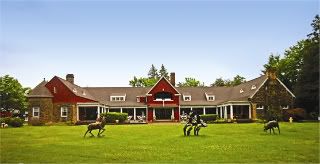
Aspen Manor image from Bed & Breakfast
Located on the hills above Wellsburg, West Virginia, Aspen Manor dates back to 1901, built by Captain Jacob "JJ" Vandergrift of Standard Oil fame for his playboy son, Joseph "JB" Vandergrift.
The estate was planned by Frank Alden and Alfred Harlow, noted Pittsburgh architects who designed many homes for the rich and famous. The manor still holds priceless museum-quality furniture and paintings inside its walls.
It was then known as Vancroft, and was quickly nicknamed the "Monte Carlo of the Ohio Valley." Vancroft's 600 acres boasted horse races, cock fights, week-long poker games, an opium den, a billiards hall, bowling alley, indoor pool, themed rooms, hunting, and fishing.
Everything JB loved was there, including, of course, some fast ladies whom he was alleged to have cavorted with frequently.
Currently, it's a B&B and hotel known as Aspen Manor after a long run as a Catholic assisted living facility and home for retired religious.
The mansion is now at the center of a police investigation after skeletal remains were found hidden in a wall, thanks to some spirit snooping by the Brooke County Paranormal Society and a spectral plea from beyond.
The voice's human remnants were presumably found after the spook seekers said they sensed someone was buried in a wall and followed a voice saying, “Help me. I’m stuck inside of this wall." They made a gruesome discovery in the basement - old bones.
They had been chopped into pieces, and were found along with glasses and hair. The remains were sent to the state medical examiner, and they were found to be chicken bones; so much for the clucking from the walls.
Vancroft's lore is that Diane Vandergrift was having an affair with a stable hand, and her hubby found out. It was not a case of what's good for the goose is good the gander.
It's said that womanizing Joseph Vandergrift couldn't take being two-timed, and had his wife killed and her body burned in the stable along with that of her lover. Other tales say she hung herself in the stable while JB had the hired hand murdered.
They too are all just part of the mythology of the place - Diane divorced Vandy in 1904, and so her spirit isn't very likely to floating around the Aspen Manor halls.
At any rate, after the divorce in 1904, Vandy left the house, never to return, taking just a few belongings along with him and forever washing his hands of his man-toy mansion.
But even with Diane and the entombed bones out of the spectral picture, lights going on and off by themselves, freezing rooms in the middle of summer, and visions of a woman who disappears in a flash have all have been reported from Vancroft. The Brooke County psychics also picked up some clicking sounds on EVP from an old convent on the grounds, the type of sound the good nuns used to warn students to hush.
Candykitten, whose hubby owns the manor, wrote to debunk the Diane stories and added that "The only ghosts here are those of the nursing home who passed on." We appreciate her input and helping to put the Diane Vandergrift tales to bed.
Friday, November 13, 2009
Friday the Thirteenth
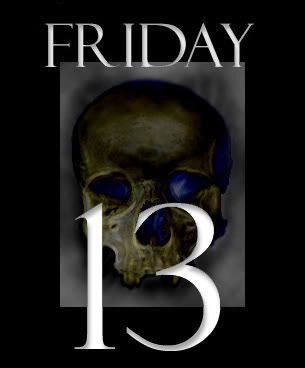
Image from
Haunted American Tours
Hey, black cats, walking under ladders, breaking mirrors...what could be worse? How about Friday the 13th?
The fear of Friday the 13th is called paraskevidekatriaphobia. Some sources it's the most widespread superstition in the United States today. About 9% of Americans believe that Friday the 13th is jinxed, according to a 1990 Gallup poll, more than any other bad-luck omen.
According to the Stress Management Center and Phobia Institute in Asheville, N.C., an estimated 17 million to 21 million people in the United States are affected by a fear of this day.
Some folk are so paralyzed by Friday the Thirteenth's bad mojo that they alter their normal daily routines, call off work, avoid taking flights, or for that matter, don't even get out of bed. It's been estimated that over $800 million is lost in business on this day.
You can trace the infamy of the number 13 back to the ancients. For starters, the dynastic Egyptians of the Pharaohs' era equated the number 13 with death (although they considered it lucky, as it marked the beginning of the afterlife).
In Norse mythology, the beloved hero Balder was killed at a banquet by the trouble-making god Loki, who crashed the party of twelve, bringing the group to, yep, 13.
It also has a basis in Christian theology. Thirteen is significant because it is the number of people who were present at the Last Supper (Jesus and his 12 apostles). Judas, the apostle who betrayed Jesus, was the 13th member of the party to arrive.
There's more lore. Legend has it that if 13 people sit down to dinner together, one will die within the year. The Turks so disliked the number 13 that it was practically expunged from their vocabulary. Many cities don't have a 13th Street; many buildings don't have a 13th floor; and many airlines don't have a 13th row of seats.
If you have 13 letters in your name, you will have the devil's luck (Jack the Ripper, Charles Manson, Jeffrey Dahmer, Theodore Bundy and Albert De Salvo all have 13 letters in their names). There are 13 witches in a coven.
Hey, Hall of Fame quarterback Dan Marino wore #13 for seventeen years. He was the hottest QB this side of Joe Namath, and still never won a Super Bowl. He never won a championship at his alma mater, Pitt, either, despite being All-America. Marino wore #13 there, too.
Friday isn't such a hot day, either, according to the Norse and later Christians.
"Friday is named for Frigga, the free-spirited goddess of love and fertility. When Norse and Germanic tribes converted to Christianity, Frigga was banished in shame to a mountaintop and labeled a witch. It was believed that every Friday, the spiteful goddess convened a meeting with eleven other witches, plus the devil - a gathering of thirteen - and plotted ill turns of fate for the coming week. For many centuries in Scandinavia, Friday was known as 'Witches' Sabbath'," explains Origins author Charles Panati.
And of course, Friday is the day that Jesus was crucified. Friday is also supposed to be the day that Eve tempted Adam with the forbidden fruit, the builders of the Tower of Babel started to babble, and that God launched the flood that drowned everything but Noah and his ark mates.
Cain slew his brother, Abel, on a Friday, and the Egyptians were visited with their 10th plague, the death of every first-born son, on that day, too.
Friday is an especially bad day to start a journey or project, and according to lore, for sailors to set sail. One hundred years ago, the British government sought to quell once and for all the widespread superstition among seamen that setting sail on Fridays was unlucky.
A special ship was commissioned, named "H.M.S. Friday." They laid her keel on a Friday, launched her on a Friday, selected her crew on a Friday and hired a man named Jim Friday to be her captain. Well, H.M.S. Friday embarked on her maiden voyage on a Friday, and was never seen or heard from again.
Some bad luck of Biblical proportions has occurred on this date in history.
On Friday the 13th of October 1066, the decision was made by King Harold II to go to battle the next day, rather than allow his troops a day of rest, despite his army having made a long and arduous march from a previous battle.
The decision to offer combat before the Brit troops were rested resulted in a bloody English defeat and King Harold's death, and helped establish Friday the 13th as an unlucky day throughout the Isles.
Katharine Kurtz in Tales of the Knights Templar (Warner Books, 1995) writes that "On October 13, 1307, a day so infamous that Friday the 13th would become a synonym for ill fortune, officers of King Philip IV of France carried out mass arrests in a well-coordinated dawn raid that left several thousand Templars — knights, sergeants, priests, and serving brethren — in chains, charged with heresy, blasphemy, various obscenities, and homosexual practices.
None of these charges was ever proven, even in France — and the Order was found innocent elsewhere — but in the seven years following the arrests, hundreds of Templars suffered excruciating tortures intended to force 'confessions,' and more than a hundred died under torture or were executed by burning at the stake."
The Aztecs brutally killed 39,000 in one day on Friday the 13th of August, 1539. This was done at the request of the recently arrived Hernan Cortez, who claimed to be a god seeking tribute. The next day he overthrew their empire.
Of course, it just may be another media creation. In 13: The Story of the World's Most Popular Superstition (Avalon, 2004), author Nathaniel Lachenmeyer argues that the pairing of "unlucky Friday" and "unlucky 13" had its genesis in the pages of a a novel published in 1907 titled — what else? — Friday, the Thirteenth.
The book, all but forgotten now, concerned dirty dealings in the stock market (everything old is new again, hey?) and sold quite well in its day. Both the phrase and the premise behind it — superstitious people regard Friday the 13th as a horridly unlucky day — were instantly adopted and popularized by the press.
Now in truth, the day was considered unlucky long before the book and was well-rooted in American folklore, but it sure helped cement the concept as a part of Americana.
At any rate, it's a way old superstition based in both mythology and Christianity. So if you decide to do anything other than stay in bed with the covers pulled over your head, well, it's your roll of the dice.
But if you're reading this, you've already survived February and March's Friday the 13ths this year, so...
Main Sources: Wikipedia and About.com.
Saturday, November 7, 2009
John Brown's Body...
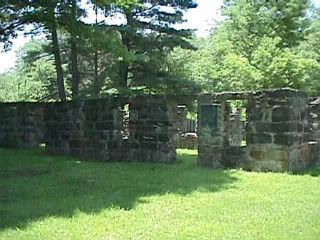
John Brown's Tannery image from Explore PA History
In Crawford County, John Brown ran a farm and tannery in New Richmond, about a dozen miles from Meadville, from 1825 to 1835. Indeed, he spent more time in New Richmond than any other place during his adult life.
It was also, as you might surmise, a major stop of the Underground Railroad, passing some 2,500 slaves through it's hidden room.
After some early success, the business eventually failed and John Brown moved on to Ohio, then New York, and marched on into history. But his body doesn't lie mouldering in the grave, according to some reports.
A tall, strapping man that many believe is John Brown has been allegedly seen here, although his spook is more commonly associated with Harper's Ferry.
It's debated whether he's returning to the place where he knew peace, or if he's drawn to the site because it's where his first wife, Dianthe, and two children are buried. In fact, one visitor claims to have a photo of Brown with his wife and kids at the small graveyard.
There's also the spirit of a black man seen at dusk and dawn, perhaps one of the escaped slaves. Voices have been heard, and there's a cemetery on the property that may be the final resting spot for the bodies of slaves, workers, family, even soldiers; no one's exactly sure who all reside there.
The place is a museum now, offering historical displays and tours. And who knows what piece of history you may run across there? Haunted Pennsylvania by Patty Wilson & Mark Nesbitt briefly covers the Tannery's spooks.
Friday, October 30, 2009
Bake Oven Knob
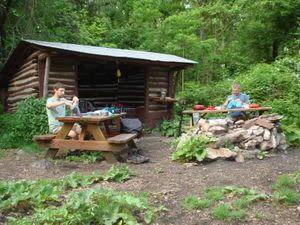
Bake Oven Knob Shelter image from Travelblog
A couple of readers wanted to know why we were holding out on the Bake Oven Knob tale mentioned last week, so for you guys, here it is...
The Bake Oven Knob Shelter in the Lehigh Valley, about 20 miles from Allentown, can best be described as a log version of a bus shelter. It's meant to provide a sleepover spot for bird watchers or a few campers as they hike the Appalachian Trail.
It's not a place for the faint of heart. You have to clamber uphill over a boulder field to get to the site. Once you're there, don't count on getting a good night's rest.
Very weird things happen around the Knob. The forest can turn from bright sunlight to complete darkness within a couple of steps. And at night, you can hear eerie murmurs and whispers in the woods, often followed by the Bake Knob beast.
One group saw a huge, shadowy entity 500 feet away from the shelter coming up Kittatinny Ridge in the middle of the night. It frightened them so much that they rolled up their sleeping bags, stuffed their gear into their rucksacks, and stumbled up the trail in the darkness rather than wait to get close up and personal with their visitor.
No one knows for sure if there's a spirit that haunts the Kittatinny ridge, but a frightful creature has been associated with the area since the days of the Delaware Indians.
It could be a misty spook; no one has ever been able to describe it with any more detail than as a glowing, red-eyed blob. Some speculate that it's a Blue Mountain Bigfoot, or maybe just a noisy feral woodland critter.
In addition, there's a local legend of a ghostly hiker, the shade of an outdoor enthusiast who fell to his death from Bake Knob's outlook and still walks the trails.
So hey, spend the day spook-hunting at the sanctuary, then cross the Kittatinny ridge and spend the night at the shelter. See what trick or treats this Halloween holds...
Friday, October 23, 2009
Hawk Mountain

Kittatinny Ridge image from Audubon Pennsylvania
What could be more peaceful than a bird watcher's perch? Well, Hawk Mountain sanctuary, in Albany Township, Bucks County, is a fine place to observe our feathered friends but also a haunt of great local renown.
The sanctuary is built on Kittatinny Ridge (also home to the Bake Oven Knob, located on the other side of the ridge and a story all of its own) which was sacred grounds for the Lenni-Lenape Indians of the area. In 1756, spurred on by the French, they massacred the Gerhardt family, who lived in a cabin on the hill.
Their ghosts have been reportedly seen roaming the area at night. The only survivor was 11 year old Matthias, who showed true pluck by eventually returning to build a new home where his family house had been. In the 1800s, Matthias Schambacher and his wife bought the place and opened a tavern and inn in the old Gerhardt house.
They didn't associate with the locals, many of whom swore they would never return to the inn after their initial visit, as also did many of the out of town guests, spooked out by the happenings at the Schambacher spread.
Footsteps could be heard coming up to the door and stopping, as if someone was eavesdropping on the occupants. Strange sounds could be heard coming from the barn. Horses would bolt as they approached the house. Bright, flashing lights and wailing sounds were reported from the surrounding hillside.
More scarily, some of the guests never traveled beyond the inn. People said you could see Matthias scrubbing blood off of the barn walls. On his deathbed, Schambacher confessed to killing at least 11 of the wayfarers that stopped at his inn, robbing them and then burying them in the woods.
But he had an excuse. He claimed that he was driven to the acts by a voice whispering in his ear, and that the area was home to great evil. He was buried in New Bethel Cemetery in an unmarked grave, and his ghost is said to be seen walking along the cemetery road. The story goes that lightning struck his grave as he was being buried, and a glowing light has been seen at the spot ever since.
After his death, another Matthias, this one a devout Catholic known for his good works, bought the house and fought the alleged evil to a standstill. Or so the locals thought.
One day, they went to his home and found the door torn off the hinges and the rooms in a shamble. There was no sign of Matthias. His mangled body was discovered a few days later, and the killer was never found.
In 1938, the property became a bird sanctuary and the building its' headquarters. From the start, odd things happened.
Wails are still heard during the night, and the floating hillside lights are still reported. Some credit the sounds to wild animals, while others believe it's the sound of the old travelers reliving their murder. Faces have been seen in the windows. Hey, on occasion the remains of one of Schambacher's victims is even unearthed around the property.
The ghost of a young girl has been reported, floating 18 inches off of the floor - the exact height that the floors were lowered when the building was renovated. She was supposed to have met her fate from a tumble down the stairs.
It's also spooked by a little German girl tooting on her penny whistle. She died falling down the steps (apparently they were pretty steep stairs!), and her parents, speaking in Deutsche, can be heard talking in the building. It's alleged that the trio were released in the structure after being disturbed during its remodeling.
The most famous spook is the 10 foot glowing man, supposedly a remnant of the sacred Indian grounds and dating back to the days of the Delawares. He's been seen throughout the area by drivers on the two-lane Hawk Mountain road and also been reported many times by people on Kittatinny Ridge. It radiates evil so powerfully that it's supposed to frighten the strongest of observers with just its presence.
One reader, Clint, dropped us a note with some local knowledge: "The historic inn and place of the murders, however, isn't at the sanctuary HQ. It is a small white building just past the sanctuary when you begin to descend the mountain. It is on the left when you are going south, and is easy to pass by without noticing. There are also rumors of a white owl spirit being spotted somewhere on the mountain. Also, there's a lower road beneath the sanctuary, at the end of this road is a very old residence where the owners have reported hearing a piano playing eerily."
So if you're looking for a haunted thrill on Halloween, save a few bucks and pay Hawk Mountain a visit. You'll be killing two birds...
Friday, October 16, 2009
Goatman

Goatman image from Monstropedia
Maryland's Goatman is a critter that paranormal bloggers just love. It's described as part man and part goat, maybe even a relative of Bigfoot.
But it's hard to get the description quite straight. Some report that the Goatman has a human body with a goat’s head, the spittin' image of Satan.
Others claim that it has a goat’s lower body with the torso of a human, like the satyr Pan of Greek mythology, the god of fields, groves, forested glens, and fertility, which plays right into the woodsy lovers' lane part of the legend.
Yet others say that it's a hairy humanoid creature roughly six feet in height, lookin' like an old-timey studio wrestler, deranged killer, or mini-Bigfoot. Geez, can't someone in Maryland buy a camera?
Anyway, Goatman likes to hang out in Prince Georges county, particularly the Bowie area. One of his favorite haunts is Cry-Baby Bridge on Governor’s Bridge Road. Its particular urban legend is that if you stop your car on the bridge and shut it off, you can hear the crying of an infant's ghost, tossed off the bridge by its unhinged young mother.
But Goatman devotees say it's not a baby's cries, but the braying of Goatman that's heard at Cry-Baby Bridge. It's a popular parking spot and lovers' lane, and it's said that Goatman likes to attack young couples doin' what comes natural, sometimes butting the car, and sometimes wielding a doubled-edged axe, depending, we suppose, on what form he's taken that night.
He's also associated with Hook lore, when a couple hear the dragging of something across their car, like a hook. The guy gets out to check on the noise, and the girl finds him a couple hours later, dead and dripping blood on the car. It's pretty similar to urban legends across the land, except for the Goatman part.
The Goatman is also known to frequent Lottsford and Fletchertown Roads, bracketing the Glenn Dale Hospital, the former site of a state tuberculosis sanatorium. There are tales of many an axe attack on parked cars in this area, some credited to Goatman and others to escaped inmates still roaming the woods. Some versions say experimental treatments turned the inmates into Goatmen.
But the most sinister stories regarding Goatman's origins concern the United States Agricultural Research Center in Beltsville, Maryland.
One two-ending story concerns a scientist that was working on genetics, using a goat as a guinea pig. In one version, the doctor went mad, and escaped into the woods, where he became a fur-covered, deranged axe-murderer.
In another, he went the mad scientist route and mutated himself into Goatman, again fleeing into the woods and visiting havoc on the community at large.
In another, an experimental cancer drug being used on an unwitting test subject backfired, spawning Goatmen.
But for fans of the KISS (Keep It Simple, Stupid) theory, Goatman is Satan incarnated, called to Maryland on occasion by his occult worshipers.
Hey, Goatman has it all: Cry-Baby Bridge, an axe, deranged scientists, genetic experiments gone wrong, Satan, Pan, Sasquatch...what more could you want from an urban legend?
Saturday, October 10, 2009
Halloween Contest: Boo Blog

Hey guys, H&H wants to spend Halloween week telling the readers' spooky tales around the ol' e-campfire. Here's the deal:
Regale us with your own true or fictional ghost story based on a Halloween theme - cemeteries, witches, resurrection stories, Bloody Mary tales, full moons, zombies, whatever gets your jack-o-lantern beaming - keep it to 750 words or fewer, and e-mail it to Haunts and History by October 24th with your nom d'plume.
A select state-wide panel of eerie experts (OK, so far H&H and LC, but hey, that covers Pittsburgh and Philadelphia) will choose a winner(s), maybe polish them up a bit, and post the terrifying tarradiddles during Halloween week.
So if you're ready to channel your inner Edgar Allan Poe or Washington Irving, get to the keyboard and spook us out.
Friday, October 9, 2009
Mothman

Mothman Plaque image from The Ashville Paranormal Society
For a thirteen month period beginning in November, 1966, a series of bizarre sightings took place around Point Pleasant, WV, at the confluence of the Ohio and Kanawha Rivers on the Ohio-West Virginia border. There were UFO sightings, poltergeist reports, but weirdest of all were the tales of Mothman.
The tale began on November 12, 1966 near Clendenin, West Virginia. Five men were preparing a grave for a burial when something that looked like a “brown human being” flew over their heads. The men were baffled. It didn't appear to be a bird, but more like a man with wings.
A few days later, riding past a deserted Point Pleasant factory on the evening of November 15, two young couples spotted something that was "shaped like a man, but bigger, maybe six or seven feet tall with big wings folded against its back" and had glowing red eyes. The couples floored their car and fled in a panic.
Moments later, they saw the same creature on a hillside. It flew after their car, which by now was zooming along at over 100 MPH down the road. "That bird kept right up with us," they said.
Later that night, a resident watching TV saw his screen go dark, followed by high-pitched whining coming from his porch and warning growls from the family hound. He went out to see what was up, and saw a pair of glowing red eyes looking back.
He went back in the house to fetch his gun while his dog chased the critter, but couldn't screw up the courage to go back out to face the eerie eyes. When he went out at daybreak, both the creature and his pooch were gone.
The red-eyed beast was busy that night. Another group of four witnesses claimed to see the “bird” three different times.
The town held a press conference the next day, and the authorities said they took the sightings seriously because of the number of reports and the credibility of the witnesses. The press immediately dubbed the critter Mothman, after a Batman nemesis.
That night, a family saw red lights flying overhead, and a visitor found out what the lights were - Mothman. She got out her car, and the creature popped up near her, causing her to drop her baby. She gathered her child and got to her hosts' front door in Olympic time. The haunting sight would stay with her for months in the form of nightmares.
Paranormal researcher and author John Keel arrived in Point Pleasant in December and immediately began compiling reports of Mothman sightings. Before he was done, he would have 100 sightings in his files from November of 1966 to November, 1967.
Here is how they described Mothman:
* approximately seven feet tall
* a ten foot wingspan
* gray, scaly skin
* large, red, glowing, hypnotic eyes
* able to take off straight up in flight, traveling up to 100 miles an hour
* liked to mutilate or eat large dogs
* screeched like a rodent or electric motor
* caused radio and television interference
* had some mind control powers.
Keel believed the creature was real, although he realized that many of the reports he got were generated by folk who were influenced by the flood of lurid Mothman publicity. But he never did say what he though Mothman actually was (which didn't stop him from writing a couple of books anyway, "The Mothman Prophecies" and "The Eighth Tower.")
Instead, he claimed that Point Pleasant was a “window” area between dimensions, a place that was susceptible to odd sightings, monster reports, UFOs, poltergeist activities, and the coming and going of eerie beings.
Others blamed the events on the Cornstalk Curse that was placed on the Point Pleasant region in the 1770's, when the Shawnee chief, his son, and two other tribesmen were gunned down in prison by vengeful soldiers for a crime they didn't commit.
His dying words were "...may the curse of the Great Spirit rest upon this land. May it be blighted by nature. May it even be blighted in its hopes. May the strength of its peoples be paralyzed by the stain of our blood." Hey, King Tut couldn't have said it better.
Other, somewhat cooler heads, theorize that the Mothman was a Sandhill Crane, which have a wingspan of 5-7 feet, a overall average length of 39 inches and an unusual shriek.
Owl theories also abound. The possibility of the Mothman being a Barn Owl, an albino owl, or perhaps a large Snowy Owl have been put forward. Skeptics suggest that the Mothman's glowing orbs are actually red-eye caused from the reflection of light, just like the ones caused by the flash of your Kodak.
But hey, whether Mothman was from the Twilight Zone or just a fat screech owl, it did spawn quite the cottage industry. We've found nine books, two movies, six TV shows, two role-playing games, two computer games, and a pair of dolls that feature the winged critter.
And Point Pleasant isn't shy about its native son. The Mothman Festival, an event held on the 3rd weekend of every September, combines a little folklore along with a lot of local tub-thumping. Hey, he even has a local museum.
Now Mothman has gone international. It is believed to be a harbinger of imminent disaster, reportedly being seen around the globe before great tragedies occur.
Not bad work for a thirteen month run in wild and wonderful West Virginia.
Friday, October 2, 2009
Loveland Lizard

Loveland Lizard image from Weird Things
Next, we'll head across Ohio towards Cincinnati, and check out the reports of its mean green machine, the Loveland Lizard (or frog).
The Algonquin Twightwees (the Miami tribe), lived in Ohio's Miami Valley and were the first to tell tales of a froggy creature. As early French explorers came by, the Twightwees warned them of a lizard-like creature that could not be killed. They called this critter Shawnahooc, meaning "demon of the river."
But after a couple of centuries spent fighting the expansion of the settlers, the Miamis were forced to relocate to Kansas, and with them went the Shawnahooc legend.
That is, until May, 1955. A businessman reported that he saw three or four frog-faced creatures gathered under a bridge near Loveland.
They were described as three-foot tall, with wrinkles instead of hair, broad chests, and wide mouths without lips, like king-sized frogs. One of them is said to have held up a wand that shot sparks. A strong odor of alfalfa and almonds was reportedly left behind after the varmints vacated the bridge.
The witness couldn't decide whether he had seen fairy-tale trolls, creatures that were half human, half frog, huge reptiles, or spacemen.
As the years rolled into decades, there were no further reported sightings of the Loveland Frog. Then the long arm of the law got involved.
On March 3, 1972, a police officer was patrolling a section of Riverside Avenue that runs along the Little Miami River in Loveland, Ohio. The policeman saw what he thought was a dog lying in the middle of the road, and slowed down his cruiser on the icy road, unsure of the animal's condition.
The cop stopped his patrol car and got out with his flashlight to check if the dog was injured or perhaps even roadkill. Suddenly, the creature crouched on two legs, and the officer realized his sighting wasn't a dog at all, but something entirely different.
It was three to four feet tall, 50 to 75 pounds, with leathery skin, maybe a short tail, and a head and face like a frog. Whatever this creature was, it glanced at the patrolman and leapt over the road's guard rail toward the river.
The officer reported the odd event to the police dispatcher, though never filing an official report, and later returned to the scene with another policeman. All they found were markings from something that had scraped along the hillside as it made its way to the river.
Two weeks later, another police officer saw it, again lying in the middle of the road. When he got out of his car to haul it to the shoulder, it got up, climbed over the guard rail, eying the policeman, and disappeared toward the river.
The cop took a shot at the creature, but it never slowed down and escaped into the waters of the Little Miami River.
A farmer in Loveland also claimed that he spotted a froglike creature during the same time frame.
A local publicity firestorm erupted, based a little bit on the sightings and a lot on Loveland politics and efforts at embarrassing people and evening scores, not an uncommon tack in small-town editorial rooms (or big city ones, for that matter.)
The second peace officer pooh-poohed the whole affair, claiming that he saw someone's tossed-out, overgrown pet lizard. He took a shot at him in an effort to bring the critter in and clear the first officer's reputation. His guess was that either he winged it and it eventually died from the wound, or that the cold got it.
An investigation came up empty, suggesting that the officers saw an escaped Nile monitor lizard or a large iguana, which can be over six feet in length. So did the sightings.
Did they actually see a lizard-man? Well, there are reports of them from other places. Some of the more renowned are the Lizardman of Wayne, New Jersey, the Giant Lizard of Milton, Kentucky, and the Lizard Man craze that swept Bishopville, South Carolina in 1988.
But for Loveland, it seemed the end of the story. The twentieth century passed by without anymore lizards littering the local roads. But...
In 2000, a visitor on vacation reported seeing the Loveland Lizard on the way to his hotel. He described it as a 4-foot-tall creature that was part human and part lizard or frog. He said it had scaly skin, webbed hands and feet and was holding a wand-like stick. Sound familiar?
The tourist tried to take a photo of the creature but he hit the flash instead of the shutter button and scared it off. Pity; a picture is worth a thousand words.
Wednesday, September 30, 2009
Haunted Pittsburgh
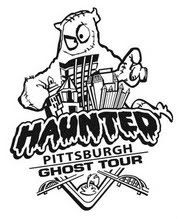
Hey, we briefly interrupt our creepy critter tour to tout Haunted Pittsburgh to our local readers and City visitors. H&H's hometown has spooks galore, but up until now, nobody has ever bothered to set up a vehicle to acquaint us with Pittsburgh's paranormal past.
And what better way to get into the Halloween spirit than with some 'Burgh boos?
First, you can get the sit-down version of the Steel City's spooks at the allegedly haunted Gypsy Cafe in South Side on 1330 Bingham Street. HP offers "dinner served with goose bumps," Wednesdays through Halloween: October 7th (7:30 start), 14th (7:30 start), 21st (8 pm start), and 28th (8 pm start).
Special Monday dinner shows October 12th and 19th feature a medium and tarot card readings. Call 381-4977 to reserve a spot for a meal and some macabre myths.
You'll be tormented by tales of spooked-out North Side mansions, Henry Clay Frick and Clayton, Roberto Clemente's premonition, Fallingwater's specter, Kaufman's ghost, and the Johnstown Flood legacy.
For the more adventurous, Haunted Pittsburgh offers a walking tour of South Side haunts, starting at the Carson Street Deli at 1507 East Carson Street, and departing at 7 and 8:30 every Friday and Saturday night. Give HP a call at 381-5335 if you like your ghosties close up and personal, click on their web site, or e-mail them at Haunted Pittsburgh. Of course, you could just walk up to the Deli and buy a ducat, too. That works.
Haunted Pittsburgh is the love child of attorneys Michelle Smith and Tim Murray. They've collected and researched some of the Three Rivers' otherworldly history, and decided hey, if ghost gambols work in Gettysburg and New Hope, why not here?
So if your only experience with Pittsburgh's spookdom is the Zombie walk, check out Haunted Pittsburgh. It sounds like a screamin' good time.
(And no, H&H is not associated with HP nor has been bribed by any ghoulish goodies. We just felt like someone working the same side of the Steel City's spectral street deserved a little love.)
Friday, September 25, 2009
Champ

Mansi picture of Champ from Genesis Park
Lake Champlain on the New York-Vermont border was named after Samuel de Champlain, the French explorer that discovered it. So is Champ, its legendary monster that was also discovered by the intrepid Monsieur Champlain.
He sighted Champ in July of 1609, and described the creature as a "20 foot serpent thick as a barrel with a head like a horse," although some think Sam saw a garfish.
But if Native American mythology is to be believed, he wasn't the first. The tribe that lived near Lake Champlain was the Abenaqi. They had their own lore concerning a creature in the lake which they called Tatoskok. The natives used to leave offerings for the creature so it wouldn't nibble on shoreline life - like the Abenaqi.
Champ, in fact, has been officially reported sighted 300 times, beginning in 1819. It's consistently described as a cross between a plesiosaur, a creature from the age of the dinosaurs, and a serpent. Some have proof.
In 1977 a photograph was taken by a tourist from Connecticut, Sandra Mansi. The Mansis were having a lake shore picnic when they saw a creature rise up out of the depths. She grabbed her Instamatic and snapped the best photo ever taken of Champ.
The print was studied by many sources and doesn't appear altered in any way, an easier thing to determine back in the pre-Photoshop days. Unfortunately, she didn't keep the negative, so there's always that question...
Champ has been video-taped at least twice. Sonar and underwater microphones have picked up evidence of a big critter lurking under the waves. Unsolved Mysteries, ABC News, and The Discovery Channel have all featured Champ.
The lake could possibly hide a monster or some lost species of dinosaur. After all, it is 109 miles long, and in some places it's 400 feet deep and pitch black.
But a word of warning - Lake Champlain is very much like Loch Ness. It is long, deep, narrow and cold. Scientists have discovered that both bodies of water have an underwater wave called a seiche that can throw debris from the bottom of the lake up to the surface. Some skeptics think this may explain many of the monster sightings.
Like the Loch Ness Monster, many authorities regard Champ is a groundless legend promoted by local tourist agencies. Others believe there's a rational explanation. According to the Lake Champlain Land Trust:
One theory suggests that Champ is a dinosaur that managed to escape extinction and lives on in Lake Champlain. Another suggests that the creatures could be surviving zeuglodons, a primitive form of whale with a long snake like body. These creatures have been thought to be long extinct, but fossils of them have been found a few miles form Lake Champlain in Vermont.
Champ might also be a Lake Sturgeon. There are sturgeon in Lake Champlain and they can grow to great lengths. They are a very old, almost prehistoric fish with a scale-less body that is supported by a partially cartilaginous skeleton along with rows of scutes. Its single dorsal fin, running along its spine, would match many descriptions of Champ, although its sharp, shark-like tail would not.
Another theory is that Champ could be related to a plesiosaur. A plesiosaur is a prehistoric water dwelling reptile (not a dinosaur) with a long snakelike head and four large flippers. Plesiosaurs loved fish and other aquatic animals. Scientists date the plesiosaur to the Triassic period, 200 million years ago, through the Cretaceous period, about 65 million years ago (when all dinosaurs are thought to have gone extinct).
And here's the ultimate proof of Champ's fame: showman P.T. Barnum posted a $50,000 reward for the "hide of the great Champlain serpent to add to my mammoth World's Fair Show."
And ol' PT would never try to pull a fast one, would he? (Although just in case, Vermont passed a bill into law in 1983 which protected the creature from human harm.)
Champ vid
Friday, September 18, 2009
White Stag of Shamong
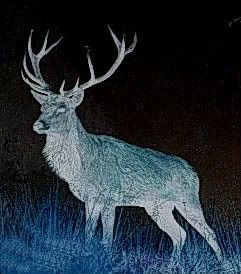
White Stag from Quark
Now we're off to New Jersey. We've already posted about the Bad Boy of the Pine Barrens, the Jersey Devil.
H&H being an equal opportunity blog, we thought we'd try to offset some of the bad press the Jersey Devil has given the state by relating the tale of a Dudley Do-Right creature, the White Stag of Shamong, in Burlington county.
To get to their Meeting House in Tuckerton, local Quakers had for decades traveled an old trail, barely more than a path, through the pine barrens. The road crossed the Batso River, which had to be forded. In 1772, several travelers drowned in its roaring waters.
After the disaster, the Friends rolled up their sleeves and built what became known as Quaker Bridge. Their trail, Quaker Bridge Road (which still exists, somewhat rerouted), soon became the most traveled route to Tuckerton, then a busy ship building town.
One rainy, lightning filled night, a stagecoach was attempting to reach a tavern, the Quaker Bridge Inn, on the other side of the river to ride out the storm. The driver breathed a sigh of relief when he saw a light in the distance from the Inn. He was close enough to the bridge to hear the rushing water roar past.
Suddenly, a White Stag appeared out of nowhere in the middle of the road, frightening the horses and blocking the stage.
With the horses snorting and rearing, the driver tied down the reins and got off the coach, trusty rifle in hand, hoping to shoo the creature away and get his passengers to the warmth and safety of the Inn. He hit the ground and tried to cluck the stag off of the road.
Then, in front of his eyes, the animal disappeared. The teamster slowly walked the approach to Quaker Bridge, looking for the White Stag. He not only couldn't the find it, but discovered that the bridge had washed out during the storm.
Had it not been for the White Stag, the stage and everyone on it would have plunged into the angry waters of the swollen Batso River.
The local Lenape tribe considered a white stag an omen of good luck. Since that day, everyone in the Barrens agreed. It's been spotted several times since, always as a warning of impending danger.
Though Shamong Township and the area is brimming with deer hunting clubs, no one has ever tried to bag a white stag thanks to that long-ago night. The last live one was spotted in 1953, but its spectral cousin is still thought to be in the Pine Barrens, watching over its travelers.
Friday, September 11, 2009
Thunderbirds
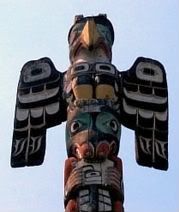
Thunderbird Totem from Wikipedia
Hey, H&H just took a road trip of college campuses. We think we're gonna hop in the ol' heap and take another cross-state spin, this time in search of creepy critters. Every state has an unexplained spooky, scaly saurian of some sort in its woods or waters.
We've already done a pair of Pennsylvania's macabre mutts, Boo-Boo Bridge's Suscon Screamer and Chickie Rock's Albawitches. Now we're after the fearsome Thunderbird.
The Thunderbird isn't a johnny-come-lately to the cryptozoid party. There have been sightings dating back way before Europeans set eyes on the Promised Land. Its winged figure has been painted on rocks and has adorned the totems of Native American lodges from sea to shining sea for centuries before the Pilgrims dropped anchor.
According to the myths, the giant Thunderbird could shoot lightning from its eyes and its wings were so enormous that they created peals of thunder when they flapped, creating storms as they flew by.
For the tribes of the local Iroquois Confederacy, Hino, the Thunderbird, was the guardian of the skies and the spirit of thunder, and could assume the form of a human when it wished.
They believed that the Thunderbirds could morph into human form by tilting back their beaks like a mask, and removing their feathers as if they were a blanket. In fact, there is lore of Thunderbirds in human form marrying into Native American families, and some tribes trace their lineage to T-Birds.
One tale tells of a clan of Thunderbirds in human form that lived along the northern tip of Vancouver Island. Other short-memoried tribes forgot the true nature of these Thunderbird families, and took them as slaves in their human shape. The Thunderbirds put on their feathers, straightened their beaks, and reverted to form to wreak vengeance upon their captors. Ah, payback...
Now there's some debate concerning the intentions of these giant birds. Some tribal legends paint them as guardians and a good omen; others consider them war-like and predatory. One thing that both sets of tales agree on is that friendly or not, you don't want to get on the bad side of a Thunderbird.
In the legends of the Miami tribe, the birds interloped while they were fighting their traditional foes, the Mestchegamies. As the battle was reaching its climax, two Thunderbirds emerged from their lair, and each snatched a Miami war chief in its talons. The Miamis dropped their weapons and fled, never to return, believing that the Great Spirit had sent the birds to help their enemies.
But the victory was double-edged. Soon after the Thunderbirds had flown off with the Miami warriors, whom they presumably devoured, the T-Birds developed a taste for human flesh. As a result, the Mestchegami paid for their conquest by having to provide regular sacrifices of their kin to sate the appetite of the Thunderbirds.
OK, OK, what about Pennsylvania? Though spotted all over the country, and for that matter, the world, no place comes close to the number of Thunderbird reports as does Pennsylvania. The Keystone State's Thunderbird stories have been traced well into the nineteenth century.
Most of the sightings come from the Black Forest region of Clinton, Potter, Lycoming, Tioga, Cameron, and McKean counties, sparsely populated areas of mainly state forests and gamelands.
Southwest Pennsylvania is another prime spot for Thunderbird watchers. Both are naturals, as the Thunderbird of legend doesn't live in an aerie, but prefers caves or mines.
Just this decade, there have been reports of Thunderbirds from South Greensburg, Erie, and Greenville. Older reports come from Bear Run, Beaver Falls, Centerville, Coudersport, Dents Run, Hammersley Forks, Hyner, Jersey Shore, Kettle Creek, Little Pine Creek, Lock Haven, Murrysville, Ole Bull, Renova, Shingletown, Sunderlinville...well, you get the picture.
Some of these sightings have been quite lengthy, one lasting 20 minutes. Several souls have seen the Thunderbird close up, either perched in a sturdy tree or hovering low overhead.
And surprisingly, most have been fairly quiet meetings; it seems that the storm birds of Six Nation myth prefer to glide through the sky, although one person described the flapping wings as making a noise like flags snapping in a strong wind.
It's hard to miss one or confuse it with an eagle or vulture. The Thunderbird has been described as having a 15-20' wingspan, standing 4-8' tall, and being dark colored; brown, gray, or black. And that description has held true pretty consistently, no matter who's spotted the Big Bird.
The largest wingspan known for a documented living bird is that of the wandering albatross, with a wingspan to 12 feet. The Andean and the California condor have wingspans of 10 feet. Many biologist believe that the Thunderbird may be a throw-back of the Condor family.
Others have posited that it's a modern day pterodactyl cousin, but until one is captured, we'll never know. There was supposed a picture taken of one in Texas years ago that was printed in a newspaper or magazine, and while many have claimed to see the photo, no one's ever found the published shot.
The most terrifying story about Thunderbirds is that they occasionally attempt to carry away family pets or children. None of those tales originated in Pennsylvania, although there have been reports of seeing the bird snatch small deer for a snack.
But if you do run across one and have Junior or Fido with you, head for cover. Remember that old Miami myth...?
Saturday, September 5, 2009
Macabre Maryland
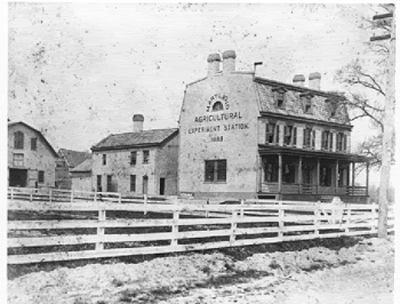
Rossborough Inn
The University of Maryland completes our regional road trip of spooky schools. The UM campus is at College Park, near to the hyper haunted towns of Baltimore and Washington, DC. And it holds its own in the realm of the paranormal.
Alpha Omicron Pi House: The girls claim to have seen and heard the ghost of a sorority sister who died in a 1995 car accident. Other phenomena include music suddenly playing, computers humming away on their own, and objects falling or moving on their own accord. It's also been reported that at least one AOP sister saw a disembodied pair of red eyes staring at her.
Davidge Hall: Davidge Hall is the oldest medical school building in the western hemisphere. One of its quirks is the fact that there are many escape routes from its rooms, dating back from the day when students sliced up cadavers illegally brought to them by grave robbers.
But for all that history, the Hall is gently haunted. Many people have a feeling of uneasiness while in building, and report hearing unexplained sounds and voices. It's not very spooked out for a body chop shop.
Delta Tau Delta House: Soon after a fraternity brother was killed in an auto accident in 1955, there were reports of strange happenings in the house. Furniture was shifted around in the middle of the night. The cook was afraid to be in the kitchen because a piece of the dead brother's furniture moved itself there, and a cabinet was always warm to the touch inside. Chairs move by themselves late at night.
This was based on a 1976 story, so whether the DTD house still is home to its departed brother's presence or not is unknown.
Easton Hall: The story here is that a freshman committed suicide by jumping out an window in the 1990s, and his spook still haunts the eighth floor of the co-ed hall.
Kappa Delta House: University Registrar Alma Preinkert was much beloved on campus. The entire UM community was stunned when she became the victim of an unsolved murder in her Washington, D.C. home in 1954. That held specially true for the KD sisters. Alma was a founder of the Kappa Delta sorority at Maryland.
She's said to haunt the halls of the sorority house she helped establish. And she's not alone; the shades of girls in white dresses dancing on the KD sundeck during the summer when the house is closed have also been reported. Otherworld rush, maybe?
Medical Center: This building used to serve as a morgue. Custodial and security staff have reported hearing strange noises and sensing a presence at night, and a feeling of ill ease bordering on fear when they enter the basement, where the cadavers were on ice. Whether they're having a natural reaction to a death house or whether there are actually ghosties bumping things in the night we'll leave for you to decide.
Morrill Hall: The Hall was built in 1898 and is the oldest campus building with its original facade intact. Workers found human remains under a sink while renovating the Hall, but it's paranormal claim to fame has more to do with sensations than spooks. The custodial and maintenance staff have heard noises late at night, and claim that people trip and fall with some netherland assistance.
But it's most known for its mysterious smells. Morrill Hall's lore includes the Thanksgiving fire of 1912, in which it was the only building to survive the blaze. It's alleged that to this day, you can still smell the smoke from conflagration that almost claimed every structure on campus.
Marie Mount Hall: Constructed in 1940 as an addition to Silvester Hall, its walls and ceilings slant at odd angles to merge with the old construction. It went by a couple of names - the Home Economics Building and the Margaret Brent Hall - until in 1967 the Board of Regents renamed it Marie Mount Hall in appreciation of Marie Mount's contributions in home economics at the university.
Campus employees claim to have seen Mount's ghost and heard her playing the piano on stormy nights, and on Halloween evening. A portrait of Marie Mount is said to watch the Hall's visitors, its eyes following their every move around the room. We guess the old Home Economics Building is the perfect eternal home for its matron.
Patterson Hall: It's allegedly spooked by a mist. An employee saw a shadow move across the wall while working alone in the building. Not the most solid case for a haunting, but hey...
Rossborough Inn/Carriage House: The Inn was built between 1804 and 1812 by John Ross, a tavern keeper. The land passed through various hands until it became part of the Calvert family holdings. In 1858, the Calverts sold 420 acres of their land, including the Rossborough Inn, to the Maryland Agricultural College, later to become UM. It's also the home of Miss Betty.
Miss Betty is alleged to have been a Civil War nurse that tended to her charges at the Rossborough Inn, and apparently she took a liking to her surroundings.
She's one of the most sighted ghosts on campus, described as short with dark hair and wearing a yellow dress. Miss Betty has been credited with turning the Inn lights on and off, showing her face in the mirror, and setting up vases with fresh flowers.
There's also lore about about a dualist who fought more bravely than well outside the Inn, and died in one of its rooms. His blood is said to reappear on the floor.
In the attached Carriage House, there's reports of two spirits sitting on stools in the first floor restaurant.
Stamp Student Union: The SU hosts a myriad of campus organizations, and they report some hazardous working conditions. Lights go on and off, elevators run by themselves, doors open and close unaided, and there are cold spots. A fire went through the building years ago, and the smell of smoke is still present. And this is where a student goes to relax?
Washington Hall: Ill-fated hoop star Len Bias' ghost is rumored to still be bouncing basketballs in his former residence hall.
But in spite of all those tales, we still think the strangest thing to haunt Maryland's campus is the statue of Jim Henson and Kermit the Frog, in front of the Stamp Student Union. Terrapins and frogs, oh my...
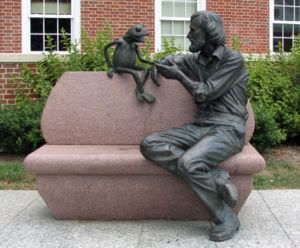
Picture from Wikia
Labels:
alpha omicron pi,
davidge hall,
delta tau delta,
easton hall,
kappa delta,
marie mount hall,
maryland medical center,
patterson hall,
rossborough inn,
stamp su,
u of maryland,
washington hall
Saturday, August 29, 2009
St. Rose's Haunted Houses
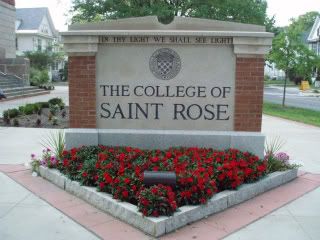
Image from michaelejahn's Picasa Web Gallery
The College of Saint Rose was established in 1920 in Albany, NY, by the Sisters of Saint Joseph, and named after Saint Rose of Lima, the patron saint of founder Mother Rosina. Does it have ghosts? Is the Pope Italian...ummm, Polish...errr, German?
Anyway, yes, it does. And just to make things easier on spook hunters, three are on the same street.
Carey Hall: Actually, calling Carey a hall is a misnomer. It's a small house on 944 Madison Avenue that's a home away from home for twelve female students.
There are a lot of stories connected to Carey. One is that a mother’s spirit is still here because her baby died in the house. The apparition of a man who went off to war is said to remain in Carey, his childhood home. This is also where the spook of a gardener hangs out.
Besides the odd sighting, there have been reports of playful antics, like tossing clothes from student suitcases all over the room after they pack up to leave the hall.
Though pranksters, the spirits in Carey are considered guardian angels of sorts. It has been reported that people would feel a warm, calming breeze in their rooms, even with the windows shut tight. It's supposedly the tranquil essence of the hall's watchful spirits.
One tale that may or may not be spirit related is that of Sister Dorothy Flood. She was home alone in Carey one day, and was headed down the steps. Suddenly she saw a ball of fire coming up the stairs toward her. She turned tail and went back up the stairs, and the mini-comet followed her. The good sister fled to her room and locked the door.
The college padre explained to her that she just ran across an example of St. Elmo's fire (though we've never heard of it taking place indoors, but hey...) and it was a good omen for Sister Flood. It's never happened again, so maybe the Father was right.
Charter Hall: Located at 923 Madison Avenue, this is a house, too, but a bit bigger than Carey. It holds sixteen co-eds.
Supposedly, the flute playing of a musician who committed suicide in Chicago can be heard here, a similar phenomena as experienced in Quillinan Hall. And no, no one's quite sure why the flutist is there.
Morris Hall: Still a house, but a big honkin' one on 568 Morris Street that was once a convent. It holds 40 co-eds.
Students there reported spotting the image of a priest in the common room, which was once a chapel for the sisters. The priest would be seen at the altar, back turned. The paranormal padre has also been seen in mirrors in the building and in windows. He was even spotting strolling down a hallway.
A renovation that divided the room with a wall between the common area and the altar space seems to have put an end to his sightings, though. But there are more spooky happenings, even with the spirit priest behind walls.
Students have reported hearing flute music, just like in Charter Hall.
The most common occurrences are in the rooms on the first floor of Morris. Things would be disturbed and moved. Music and lights would go off and on. Odds and ends placed on the window sill would fly off and crash in the middle of the room. Ghosts hate being ignored.
Quillinan Hall: The hall was named after Mother Rosina, who founded the college and was baptized Ellen Quillinan (thanks Reo!) The house is on 953 Madison Avenue, and used to be the home of a family with a little girl. Starting in the 1970s, it was reported that a young girl would show up in the house, asking the residents if they'd like to play with her.
The identity of the child's apparition was identified, according to St. Rose lore, by students who brought in an Ouija board to communicate with her. The spirit told the students that she was seven years old and died in a fire.
The only problem was there was no known blaze at the building. But shortly after, the underside of the stairs going from the first to the second floor were found to be charred during renovations to the house, confirming the girl's tale.
The moppet has been known to play tricks on the residents. She particularly likes to lock students out of their rooms and play jacks while people try to sleep.
Don't believe us? Well, the Dean of Students delivers an orientation speech every year to the incoming frosh. And he always mentions the spooks of St. Rose's. Would he fib to those dewy-eyed freshmen? We say never!
Labels:
carey hall,
charter hall,
morris hall,
quillinan hall,
st rose college
Saturday, August 22, 2009
Dark And Stormy Drew
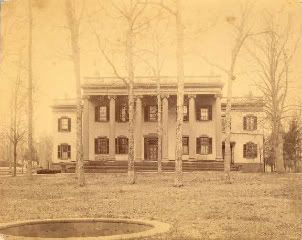
Mead Hall - 1885
Drew University was established in 1867 as a Methodist seminary in Madison, part of Morris County, New Jersey, and 15 miles as the crow flies from Times Square. Now it's a university with three clusters: a liberal arts college, a humanities-centered graduate school, and a theology school. And if that sounds like a good mix for a few spooks to you, well, you're right.
The Arboretum: The Zuck Arboretum is a collection of on-campus fresh water ponds used by the University for Environmental and biological studies. The arboretum is said to be haunted by a “lady in blue” who appears near a lake in the back of the woods and trips students and staffers. Mischievous little spook, hey?
She shows up most often at sunset, but there have been daylight sightings, too. She's opaque, and no one has ever seen her face or body, just her blue dress as it wafts by.
Asbury Hall: Built by in 1834, the building originally was a carriage house. In 1867, Asbury Hall became home to its seminary students. Now it's a residence hall. People report seeing mists rolling along Asbury's halls, along with cold spots and unexplained nosies. According to college lore, a seminary student hung himself from the attic rafters, and the mist is his spirit still roaming the dorm.
Craig Chapel: Built in 1899 on the second floor of Seminary Hall, the Chapel is gently haunted. People have felt a sense of presence in the otherwise empty chapel, accompanied by heavy breathing.
The Great Hall: The Samuel W. Bowne Hall, built in 1912, is where The Great Hall is located. It was once a dining room; now it hosts many Drew events. Bowne is a medieval structure in the middle of campus, where the teachers have their offices. The Great Hall is modeled after the hall of Christ Church at Oxford University. The upper floor is a long, red-carpeted room, with wood paneling featuring carvings along the beams, a large fireplace, paneled doors, and lead glass windows.
Sometimes there are uninvited guests to the college events held at The Great Hall. People have reported seeing faces in the ceiling carvings, the chandeliers swing for no reason, and visitors have seen reflections of a man with round, gold spectacles in a mirror. TGH spooks aren't any more friendly than the Lady In Blue; people report being pushed towards the door, as if being rudely asked to leave.
Hoyt-Bowne Hall: Opened in 1894, the hall is a popular upperclassmen residence. There's a sad tale connected to it, and with several versions. The legend goes that a girl from room #412/#403 discovered she was pregnant/messily broke up with her boyfriend, and then hung herself/was thrown out the window to her death. Mix and match the story to your satisfaction; the next part everyone seems to agree on.
Weird stuff happens on the fourth floor. Witnesses have seen doors open and window shades fly up. And woe to you if you happen to be of the male persuasion; the spook at Hoyt is definitely hostile to the guys. She knocks them down, pushes them, and has even been blamed for a broken limb or two. Drew has wisely used the top floor as an all-female residence.
The floor is so famously haunted that it's mentioned on Drew's official site.
It's also been reported that a colonial soldier will occasionally pop up on Hoyt's front lawn, scaring the bejabbers out of strollers and then disappearing. It's said that Hoyt was built partially over an old graveyard, and he was one of the disturbed bodies.
A part of the underground railroad stretches underneath the campus, and the tunnels start at Hoyt. A visit will fill one with appropriate spooky sensations, though no real tale has sprung from the tunnels.
Kirby Theater: The FM Kirby Shakespeare Theater is relatively new on campus, but built on the bones of an old gym. It's haunted by one of its gym rats, Reggie. He's usually seen on premise in shorts or sweatpants. In one well known story, a couple of stagehands, leaving the building, said "Goodnight, Reggie." The lights flicked on and off in reply.
The Library: Founded in 1867 with the school, it's supposed to sport a spook in the A-deck stacks.
Mead Hall: Mead was built in 1837. Daniel Drew, the college founder, bought it in 1867 and renamed it after his wife, Roxanna Mead. It's said that her spirit has been spotted roaming the halls.
Her most famous sighting was during a fire, when two Madison firefighters saw a woman dressed in period clothes walking calmly through the flames. They called out to her, to lead her to safety. She vanished before their eyes.
Its final spooky memento - it's said that the eyes of the first floor paintings in the building follow you around as you walk the floor.
Hey, it sounds like Drew is trying to elbow in on the Catholic school ghost monopoly. The more the merrier, we say. Keep it ecumenical.
Labels:
asbury hall,
craig chapel,
drew university,
hoyt hall,
kirby theater,
mead hall,
the great hall,
zuck arboretum
Saturday, August 15, 2009
Spooky Seton Hill
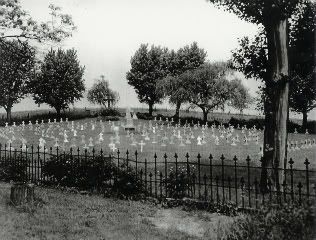
Sisters' Cemetery from Historic Campus Architecture
Founded by the Sisters of Charity in 1918, Greensburg's Seton Hill University started out as a small liberal arts college for women. It has since grown into a 2000-student coeducational university. Some of its buildings date back a century or more, and like any Catholic college worth its salt, it has its campus ghosts.
Administration Building: In the early 1900's, an elderly sister fell asleep in the basement of the Motherhouse, now used as the administration building. A custodian saw her laying there and assumed she was dead, and she was buried alive (the good sister must have been quite a heavy sleeper!) When she woke up in a pine box, she beat on the lid of the casket until she finally passed away for real. It's said that you can hear the spirit of the nun pounding away in the Administration building late at night.
Brownlee Hall: It's alleged that footsteps can be heard running up and down the hall of the first floor of the freshman woman's dorm at night. However, whenever a student opens their door to investigate, no one can be seen, even as the noise goes on.
More lore is that you can see the shadow of a girl that hung herself in her dorm room, cast on the wall. There's also the story of a mysterious purple light that comes out of the corner of a first floor room.
Maura Hall: Built in 1908, this is where the Media Center is located and the upper-class women are dormed at SHU. The spirits of the old teaching nuns have been reported roaming its corridors.
Main Parking Lot: The ghost of a priest has been seen crossing the main lot during the evening.
St. Joseph's Chapel: It's located on the third floor of the Administration building, and was built in 1896 as part of the original Motherhouse. It features the apparition of a nun in the right hand room next to the organ. The organ door will open and close on its own, and a chorus of ghostly voices singing and music coming from the otherwise empty room is often heard.
Also, there's the legend of a student who became so depressed that she went to the bell tower (the entrance is in the chapel), and threw herself off, committing suicide. Her ghost is also said to be seen around campus.
Sisters' Cemetery: The graveyard was planned and laid out in 1889 when the Seton Hill Motherhouse was completed. It's the final resting place of the Seton Hill Sisters of Charity, the founders of the university, all the past presidents, and several other notable priests, laymen, and laywomen.
A little boy is one spook, playing with a ball and occasionally running like someone is chasing him, screaming all the while.
Another tale is of a woman who stops traffic on the road so she can cross (or hitch a ride), but when the driver brakes and looks for her, she has already disappeared into the fog.
Also reportedly spotted in the college boneyard are the spirits of sisters gone and buried who once lived at Seton Hill. One story regarding demonic grave circles can be discounted, though. The original layout of the sisters' burial plots was circular, but that configuration proved to be too space consuming, and was replaced by the traditional rows of graves.
Wooo, busy campus - no wonder it's the one of the sites where the horror film On Sabbath Hill was shot!
Labels:
administration building,
brownlee hall,
maura hall,
motherhouse,
seton hill,
sisters cemetery,
st josephs chapel
Subscribe to:
Posts (Atom)

